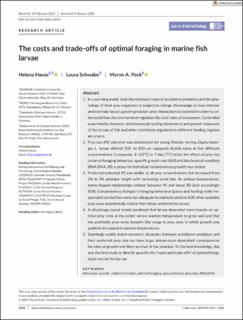| dc.contributor.author | Hauss, Helena | |
| dc.contributor.author | Schwabe, Laura | |
| dc.contributor.author | Peck, Myron A. | |
| dc.date.accessioned | 2023-08-14T06:28:38Z | |
| dc.date.available | 2023-08-14T06:28:38Z | |
| dc.date.created | 2023-04-05T09:26:26Z | |
| dc.date.issued | 2023 | |
| dc.identifier.citation | Journal of Animal Ecology. 2023, 92 (5), 1016-1028. | en_US |
| dc.identifier.issn | 0021-8790 | |
| dc.identifier.uri | https://hdl.handle.net/11250/3083681 | |
| dc.description.abstract | In a warming world, both the metabolic rates of ectotherm predators and the phenology of their prey organisms is subject to change. Knowledge on how intrinsic and extrinsic factors govern predator–prey interactions is essential in order to understand how the environment regulates the vital rates of consumers. Controlled experiments, however, simultaneously testing behavioural and growth responses of the larvae of fish and other ectotherm organisms in different feeding regimes are scarce. Prey size (PS) selection was determined for young Atlantic herring Clupea harengus L. larvae offered 100- to 850-μm copepods Acartia tonsa at five different concentrations. In separate, 4- (13°C) or 7-day (7°C) trials, the effect of prey size on larval foraging behaviour, specific growth rate (SGR) and biochemical condition (RNA:DNA, RD, a proxy for individual instantaneous growth) was tested. Preferred (selected) PS was similar at all prey concentrations but increased from 3% to 5% predator length with increasing larval size. At various temperatures, dome-shaped relationships existed between PS and larval RD (and accordingly SGR). Compensatory changes in foraging behaviour (pause and feeding strike frequencies) existed but were not adequate to maintain positive SGR when available prey were substantially smaller than those preferred by larvae. A physiology-based model predicted that larvae depended more heavily on optimal prey sizes at the colder versus warmer temperature to grow well and that the profitable prey niche breadth (the range in prey sizes in which growth was positive) increased at warmer temperatures. Seemingly subtle match-mismatch dynamics between ectotherm predators and their preferred prey size can have large, temperature-dependent consequences for rates of growth and likely survival of the predator. To the best knowledge, this was the first study to directly quantify the “costs and trade-offs” of optimal foraging in marine fish larvae. | en_US |
| dc.language.iso | eng | en_US |
| dc.rights | Navngivelse-Ikkekommersiell 4.0 Internasjonal | * |
| dc.rights.uri | http://creativecommons.org/licenses/by-nc/4.0/deed.no | * |
| dc.title | The costs and trade-offs of optimal foraging in marine fish larvae | en_US |
| dc.title.alternative | The costs and trade-offs of optimal foraging in marine fish larvae | en_US |
| dc.type | Peer reviewed | en_US |
| dc.type | Journal article | en_US |
| dc.rights.holder | © 2023 The Authors | en_US |
| dc.description.version | publishedVersion | en_US |
| cristin.ispublished | true | |
| cristin.fulltext | original | |
| cristin.qualitycode | 2 | |
| dc.identifier.doi | 10.1111/1365-2656.13915 | |
| dc.identifier.cristin | 2139448 | |
| dc.source.journal | Journal of Animal Ecology | en_US |
| dc.source.volume | 92 | en_US |
| dc.source.issue | 5 | en_US |
| dc.source.pagenumber | 1016-1028 | en_US |

